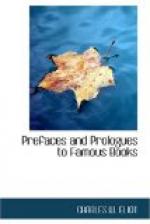More especially it imposes its characteristic qualities upon that wonderful architecture which, in the Middle Ages, takes the place of all the arts. It affixes its mark on the facades of cathedrals, frames its hells and purgatories in the ogive arches of great doorways, portrays them in brilliant hues on window-glass, exhibits its monsters, its bull-dogs, its imps about capitals, along friezes, on the edges of roofs. It flaunts itself in numberless shapes on the wooden facades of houses, on the stone facades of chateaux, on the marble facades of palaces. From the arts it makes its way into the national manners, and while it stirs applause from the people for the graciosos of comedy, it gives to the kings court-jesters. Later, in the age of etiquette, it will show us Scarron on the very edge of Louis the Fourteenth’s bed. Meanwhile it decorates coats of-arms, and draws upon knight, shields the symbolic hieroglyphs of feudalism. From the manners, it makes its way into the laws, numberless strange customs at test its passage through the institutions of the Middle Ages. Just as it represented Thespis, smeared with wine-lees, leaping in her tomb it dances with the Basoche on the famous marble table which served at the same time as a stage for the popular farces and for the royal banquets. Finally, having made its way into the arts, the manners, and the laws, it enters even the Church. In every Catholic city we see it organizing some one of those curious ceremonies, those strange processions, wherein religion is attended by all varieties of superstition—the sublime attended by all the forms of the grotesque. To paint it in one stroke, so great is its vigour, its energy, its creative sap, at the dawn of letters, that it casts, at the outset, upon the threshold of modern poetry, three burlesque Homers: Ariosto in Italy, Cervantes in Spain, Rabelais in France.
It would be mere surplusage to dwell further upon the influence of the grotesque in the third civilization. Every thing tends to show its close creative alliance with the beautiful in the so called “romantic” period. Even among the simplest popular legends there are none which do not somewhere, with an admirable instinct, solve this mystery of modern art. Antiquity could not have produced Beauty and the Beast.
It is true that at the period at which we have arrived the predominance of the grotesque over the sublime in literature is clearly indicated. But it is a spasm of reaction, an eager thirst for novelty, which is but temporary, it is an initial wave which gradually recedes. The type of the beautiful will soon resume its rights and its role, which is not to exclude the other principle, but to prevail over it. It is time that the grotesque should be content with a corner of the picture in Murillo’s loyal frescoes, in the sacred pages of Veronese, content to be introduced in two marvellous Last Judgments, in which art will take a just pride, in the scene of




